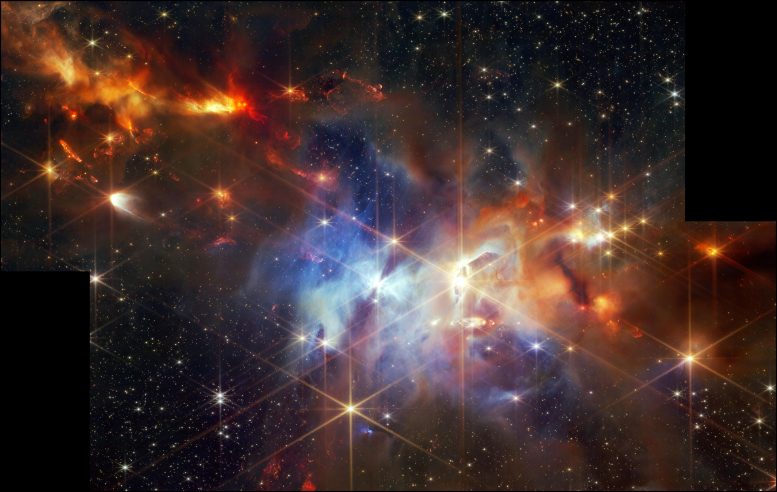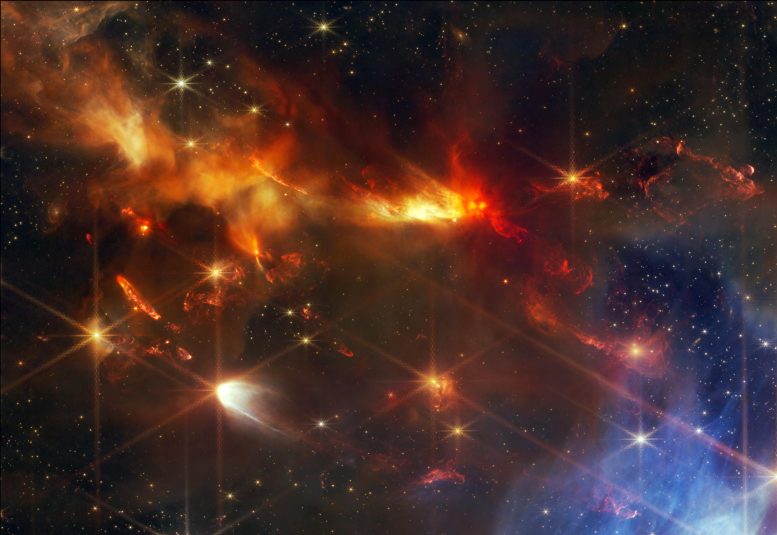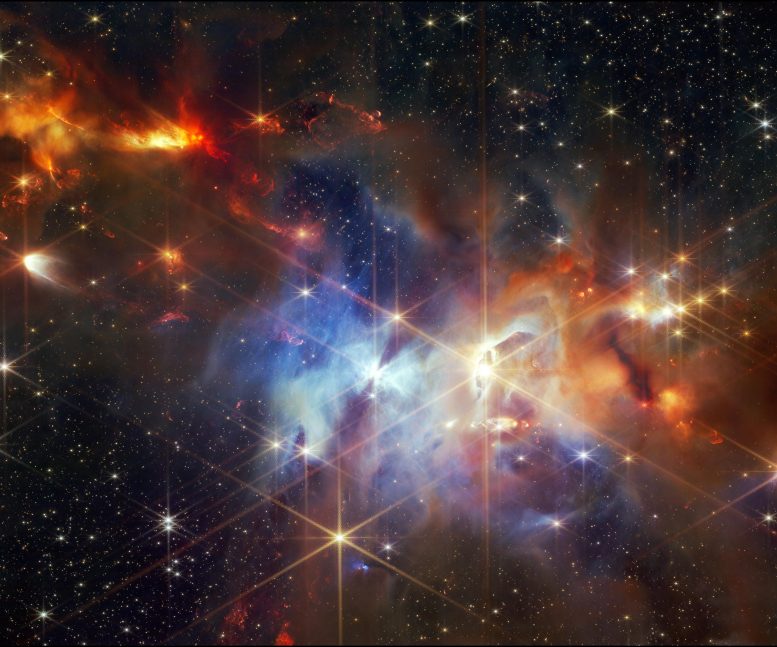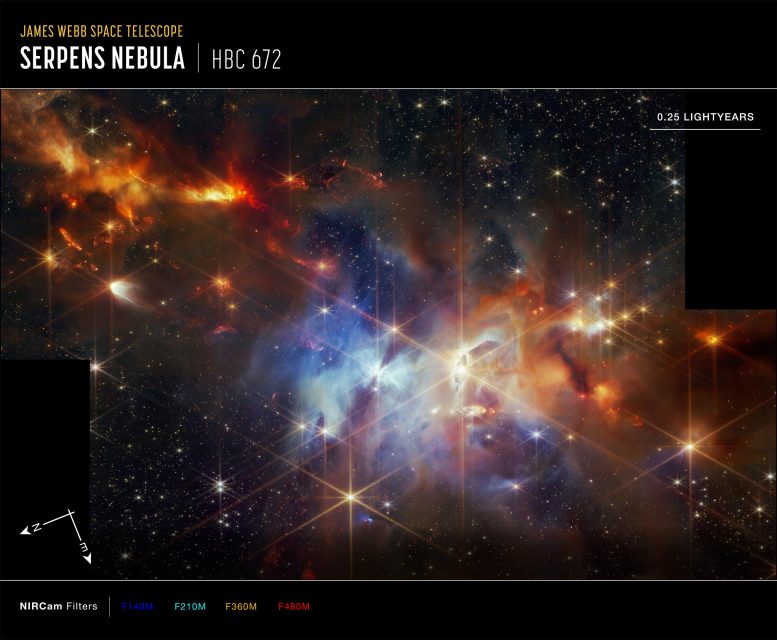
In this image of the Serpentine Nebula from the Near Infrared Camera (NIRCam) on NASA’s James Webb Space Telescope, astronomers found a cluster of protostellar outflows lined up within a small region (upper left corner). In Webb’s image, these jets are signified by bright clustered streaks that appear red, which are shock waves from the jet hitting the surrounding gas and dust. Credit: NASA, ESA, CSA, STScI, Klaus Pontoppidan (NASA-JPL), Joel Green (STScI)
The alignment of the bipolar jets confirms theories of star formation
Some of the biggest and most interesting astronomical discoveries have come as a surprise to researchers, even when examining the most studied areas of the sky.
Often, it is new technology or fortuitous timing that results in these discoveries. In a new study of the Serpens Nebula with NASAS ‘ The James Webb Space Telescopethey are both.
In one region of the nebula, Webb has resolved what previously appeared to be fuzzy blobs into clear protostellar streams. And much to the researchers’ surprise, these outflows are seen to be aligned, suggesting that we have captured this region at a unique moment in its history and providing information on the basics of how stars are born.
First-of-its-kind discovery made in stunning new Webb Space Telescope image
For the first time, a phenomenon that astronomers have long hoped to image directly has been captured by NASA’s James Webb Telescope Near Infrared Camera (NIRCam). In this stunning image of the Serpens Nebula, the discovery lies in the northern region (seen in the upper left) of this young region, close to star formation.
Astronomers found an intriguing array of protostellar outflows, formed when jets of gas ejected from newborn stars collide with nearby gas and dust at high speeds. Usually these objects have different orientations within a region. Here, however, they are sloping in the same direction, at the same rate, as rain falling during a storm.
The detection of these aligned objects, made possible by Webb’s fine spatial resolution and sensitivity at near-infrared wavelengths, provides information on the basics of how stars are born.
“Astronomers have long assumed that as clouds collapse to form stars, the stars will tend to rotate in the same direction,” said principal investigator Klaus Pontoppidan, of NASA’s Jet Propulsion Laboratory in Pasadena, California. “However, this has not been seen so directly before. These elongated, aligned structures are a historical record of the fundamental way stars are born.”

This image from NASA’s James Webb Space Telescope shows part of the Serpentine Nebula, where astronomers discovered a cluster of aligned protostellar outflows. These jets are signified by bright clustered streaks that appear red, which are shock waves from the jet hitting the surrounding gas and dust. Here, the red color represents the presence of molecular hydrogen and carbon monoxide. Credit: NASA, ESA, CSA, STScI, Klaus Pontoppidan (NASA-JPL), Joel Green (STScI)
Mechanics of star formation
So how does the alignment of the stellar planes relate to the rotation of the star? As a cloud of interstellar gas collides with itself to form a star, it rotates faster. The only way for the gas to continue moving inward is to remove some of the spin (known as angular momentum). A disk of material forms around the young star to transport material downward, like an eddy around a drain. The rotating magnetic fields in the inner disc launch some of the material into twin jets that shoot out in opposite directions, perpendicular to the material disc.
In Webb’s image, these jets are signified by bright clustered streaks that appear red, which are shock waves from the jet hitting the surrounding gas and dust. Here, the red color represents the presence of molecular hydrogen and carbon monoxide.

This image shows the center of the Serpentine Nebula as seen by NASA’s James Webb Telescope Near Infrared Camera (NIRCam). In this image, throughout the region, filaments and filaments of different hues represent reflected starlight from protostars still forming within the cloud. In some areas, there is dust in front of that reflection, which appears here with a diffuse orange tint. Credit: NASA, ESA, CSA, STScI, Klaus Pontoppidan (NASA-JPL), Joel Green (STScI)
Improved imaging techniques
“This area of the Serpens Nebula — Serpens North — comes into sharp view only with Webb,” said lead author Joel Green of the Space Telescope Science Institute in Baltimore. “We are now able to capture these extremely young stars and their outflows, some of which previously appeared only as dots or were completely invisible at optical wavelengths due to the thick dust surrounding them.”
Astronomers say there are several forces that could potentially change the direction of outflows during this period of a young star’s life. One way is when binary stars orbit each other and oscillate in orientation, distorting the direction of the outflows over time.

This image of the Serpens Nebula, captured by the Web Near Infrared Camera (NIRCam), shows the compass arrows, scale bar, and color key for reference.
The north and east compass arrows indicate the orientation of the image in the sky. Note that the relationship between north and east in the sky (as seen from below) is reversed relative to the directional arrows on a map of the earth (as seen from above).
The scale bar is labeled in light years, which is the distance light travels in one Earth-year. One light year is equal to about 5.88 trillion miles or 9.46 trillion kilometers.
This image shows invisible near-infrared wavelengths of light that have been translated into visible light colors. The color key indicates which NIRCam filters were used during light collection. The color of each filter name is the color of visible light used to represent the infrared light passing through that filter.
Credit: NASA, ESA, CSA, STScI, Klaus Pontoppidan (NASA-JPL), Joel Green (STScI)
The stars of the Serpent Nebula
The Serpens Nebula, located 1,300 light-years from Earth, is only a million or two years old, which is very young in cosmic terms. It is also home to a particularly dense cluster of newly formed stars (~100,000 years old), seen in the center of this image. Some of these stars will eventually grow to the mass of our Sun.
“Webb is a new machine for finding stellar objects,” Green said. “In this field, we get charts of every new star, down to the lowest mass stars.”
“It’s a very complete picture that we’re seeing now,” Pontoppidan added.
So, throughout the region in this image, filaments and filaments of different hues represent reflected starlight from protostars still forming within the cloud. In some areas, there is dust in front of that reflection, which appears here with a diffuse orange tint.
This region has been home to other serendipitous discoveries, including the colliding “Bat Shadow,” which got its name when 2020 data from NASA Hubble Space Telescope discovered the disk of a planet-forming star to collide or drift. This feature is visible in the center of Webb’s image.
The road to future research
The new image, and the remarkable discovery of aligned objects, is actually just the first step in this scientific program. The team will now use Webb’s NIRSpec (Near Infrared Spectrograph) to probe the chemical composition of the cloud.
Astronomers are interested in determining how unstable chemicals survive the formation of stars and planets. Volatiles are compounds that sublimate, or change from a solid directly to a gas, at a relatively low temperature – including water and carbon monoxide. They will then compare their findings with the quantities found in the protoplanetary disks of similar-type stars.
“In the most basic form, we are all made of matter that comes from these volatiles. Most of the water here on Earth originated when the Sun was a baby protostar billions of years ago,” said Pontoppidan. “Looking at the abundance of these critical compounds in protostars just before their protoplanetary disks formed could help us understand how unique the circumstances were when our solar system formed.”
These observations were taken as part of the General Observer 1611 program. The team’s initial results have been accepted for publication in Astrophysical Journal.
The James Webb Space Telescope (JWST) is a large, space-based observatory launched in December 2021. It is the scientific successor to the Hubble Space Telescope. Equipped with a 6.5-meter primary mirror, JWST specializes in observing the universe in the infrared spectrum, allowing it to look further back in time than ever before. This capability enables the telescope to study the formation of the first galaxies, the evolution of stars and planetary systems, and the atmospheres of distant exoplanets. Positioned at the second Lagrangian point (L2), approximately 1.5 million kilometers from Earth, JWST is designed to provide unprecedented resolution and sensitivity, opening new windows into the cosmos.




Leave a Reply